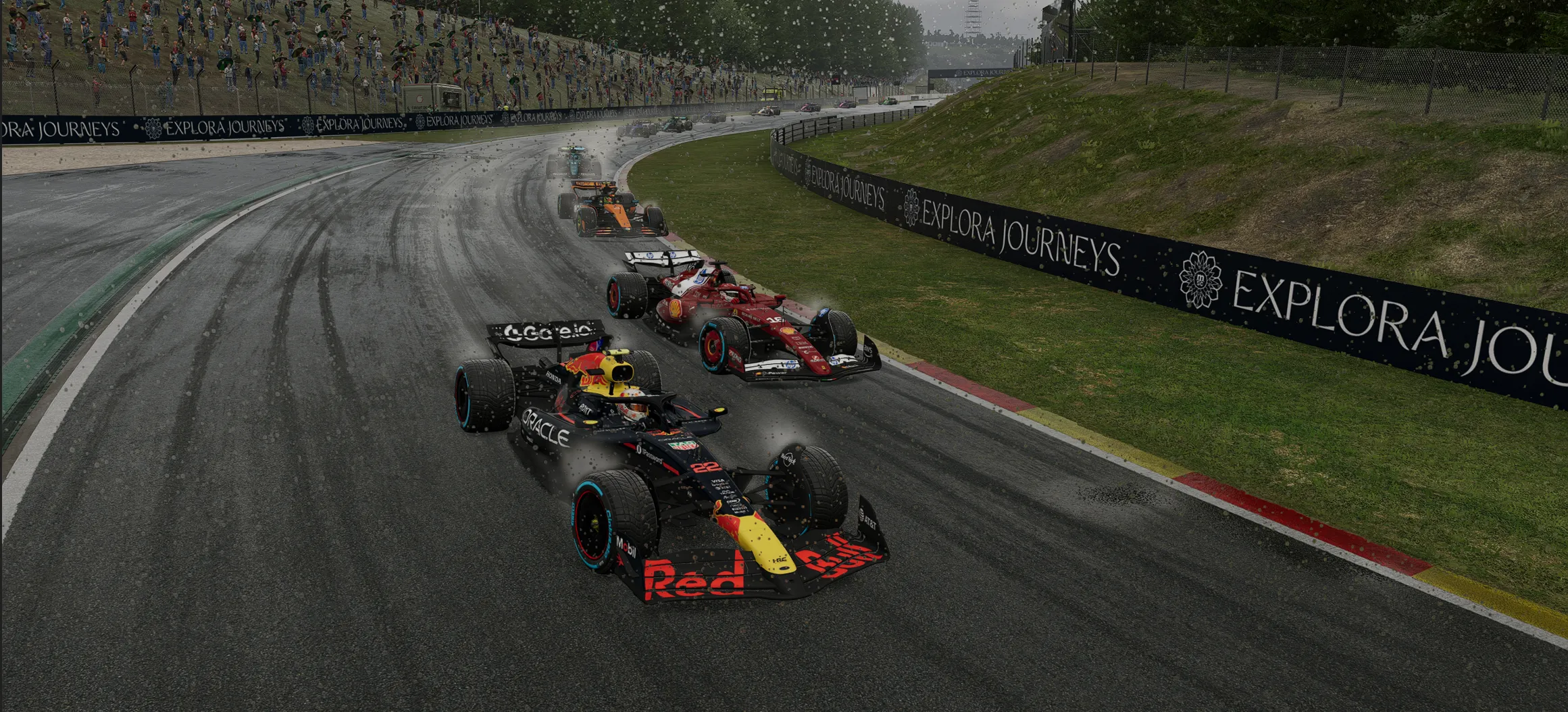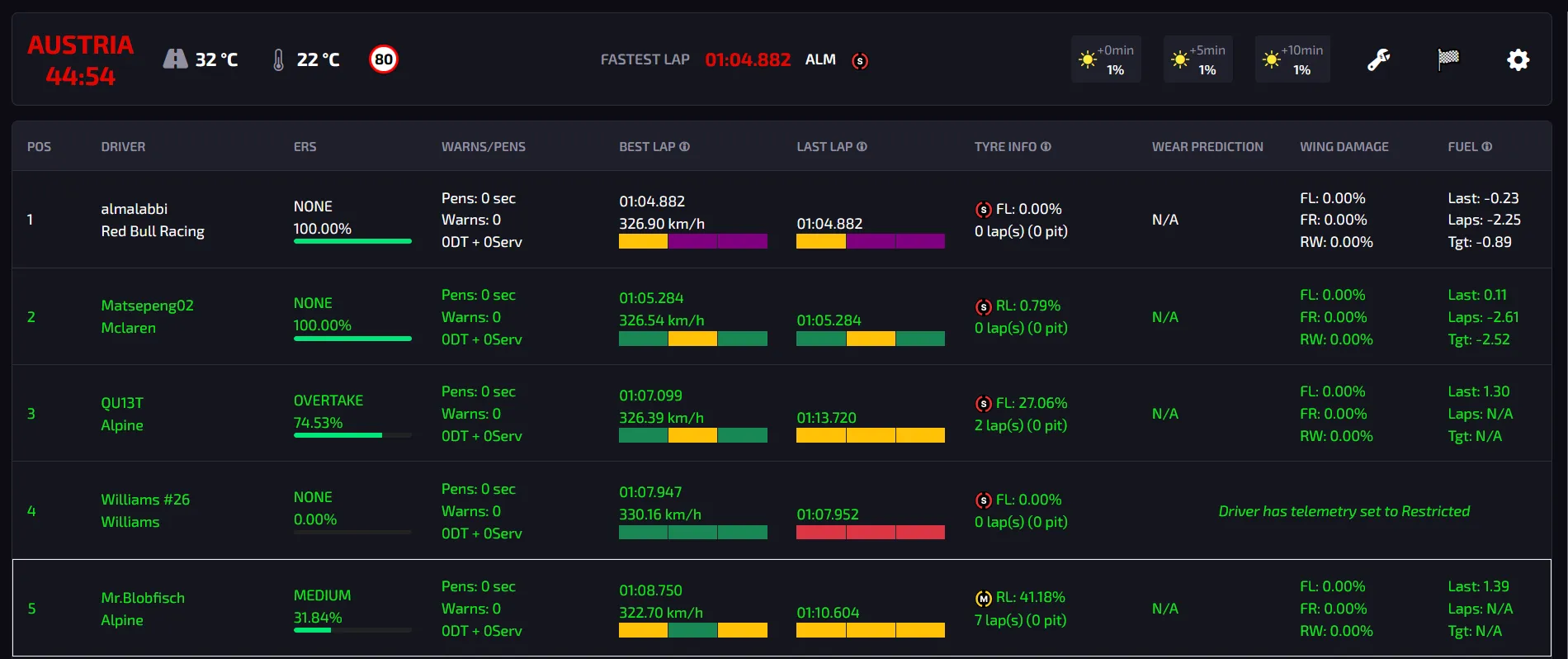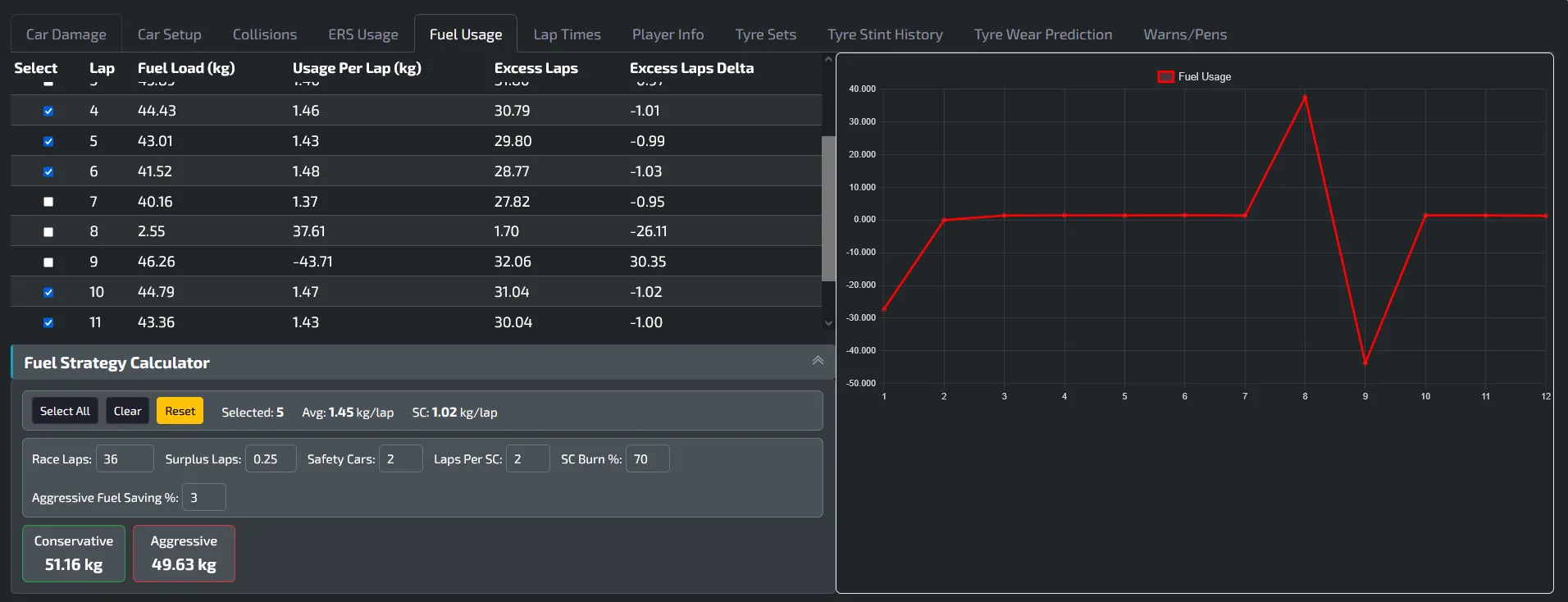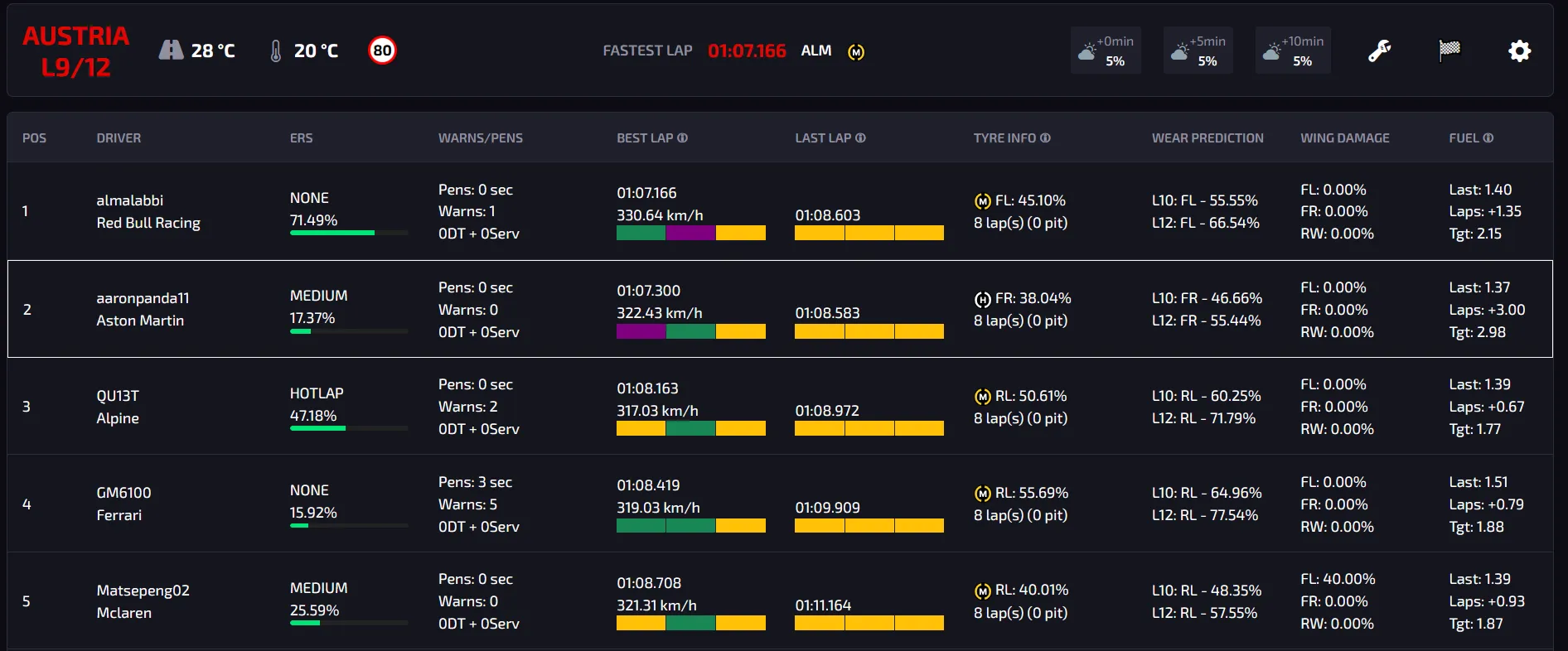Fuel Strategy Planning for League Racing

🏎️ Fuel Strategy Planning in F1 Sim Racing Using Pits n’ Giggles
In F1 sim racing, nailing your fuel strategy is absolutely essential-not just to avoid running out of fuel, but to optimize performance over the entire race. The less fuel you carry, the lighter your car. And a lighter car means:
- Better acceleration out of corners
- Reduced tyre wear
- Faster lap times over a stint
Carrying just the right amount of fuel can be the difference between winning your race and limping to the finish. That’s why Pits n’ Giggles, a race engineering companion built specifically for F1 Sim Racing, includes a powerful fuel usage analysis and real-time prediction system.
If you’re curious how this works under the hood, check out our deep dive: 👉 How Real-Time Fuel Burn Prediction Works in Pits n’ Giggles
🧰 Requirements
- Driver PC (You):
- Sim game like F1 25, F1 24, F1 23, with UDP telemetry output enabled.
- Pits n’ Giggles setup and running (get it here).
🔧 Step-by-Step: Building a Race-Fit Fuel Strategy
To get the most from the fuel calculator in Pits n’ Giggles, follow this tried-and-tested method during your F1 league racing prep:
✅ Step 1: Setup a Representative Practice Session
Start an online session that mimics your upcoming race weekend:
- Use Grand Prix (GP) or Free Practice (FP) mode with the correct race length: 25%, 50%, or 100%.
- Fit the expected race tyre compound-usually Mediums or Hards.
- Begin with approximately 40 kg of fuel in the car.
Then, go out and drive 7–8 clean, consistent laps:
- Use DRS when available.
- Use ERS (overtake mode) conservatively-just as you would in a race. Maintain your ERS levels as you would in the race after say lap 5.
- Focus on race pace, not qualifying pace. The goal is to create reliable telemetry data that reflects real race conditions.
🧪 These laps form the foundation for accurate fuel modeling. Speed doesn’t matter-consistency does.
This is the type of prep real engineers do for F1 esports and sim racing championships-and now, so can you.

✅ Step 2: Use the Fuel Calculator in Pits n’ Giggles
After completing your stint and letting Pits n’ Giggles capture the session’s telemetry:
- Open the Driver/Engineer View.
- Click your driver name to bring up detailed telemetry data.
- Switch to the “Fuel Usage” tab.
🧠 Select Representative Laps
Because the app can’t automatically detect in-laps, out-laps, or cooldown laps, it’s up to you to manually select only the valid race laps using the checkboxes in the lap list.
This limitation exists because the F1 25 game’s UDP telemetry output does not provide any flags or markers indicating the type of lap. There’s no reliable way to distinguish between a push lap and a cooldown lap programmatically. As a result, Pits n’ Giggles gives you full control over which laps are used for fuel modeling-ensuring your strategy is based only on meaningful, representative data.
Then:
-
Input the total race lap count.
-
(Optional) Fine-tune with advanced settings:
Field Description Recommended Value Surplus Laps Safety buffer 0.5–1.0 (default: 1) Predicted Safety Cars Number you expect 0–2 SC Fuel Burn Rate (%) % of race burn during SC 50–70% Lift-Coast Fuel Saving (%) Saving from LiCo 3–5%
NOTE: Any saving more than 5% through LiCo is probably going to result in significant loss of pace!
This is far more customizable-and far more accurate-than the simplistic surplus-lap estimate used by the in-game F1 25 fuel calculator.

🧮 Why Pits n’ Giggles Beats the In-Game Fuel Calculator
The default fuel prediction in F1 25 is based on a static, one-size-fits-all burn rate. It ignores your:
- Setup
- Driving style
- Track layout
- Use of ERS or DRS
You’re forced to guess how many extra laps of fuel you’ll need-often ending up way too heavy or dangerously light.
Pits n’ Giggles solves this by building a telemetry-driven fuel model, powered by your actual race pace:
- Captures data from live telemetry or saved stints
- Models fuel burn per lap based on real inputs
- Adjusts predictions dynamically over time
This approach mirrors what real teams do in F1 telemetry analysis, and it’s especially powerful in league racing where the margins are razor-thin.
💡 Since practice data is gathered in clean air and with high fuel, predictions are naturally conservative. On race day, you’ll benefit from slipstream and lower fuel weight, often burning slightly less than predicted.
To learn how the prediction model works technically: 👉 How Real-Time Fuel Burn Prediction Works in Pits n’ Giggles
🎁 Bonus: Monitor Fuel Live During the Race
If you’re running Pits n’ Giggles live during the race, the Laps column in the telemetry view gives you real-time feedback to help adjust on the fly. It includes:
| Field | What it shows |
|---|---|
| Last | Fuel burned on the last lap (in kg) |
| Laps | Surplus or deficit of laps worth of fuel remaining |
| Tgt | Target fuel burn for the current lap |
🧠 Example:
If:
Last = 1.5 kgTgt = 1.4 kg
…then you’re burning slightly more than planned, and should consider saving fuel using:
- Lift-and-coast techniques
- Short-shifting
- Minimizing ERS deployment
If the Laps value turns negative, you’re at risk of not finishing-save aggressively or plan for an early push and late coast.

🏁 Final Thoughts
Fuel strategy in F1 sim racing is more than just avoiding a DNF. It’s about maximizing pace, minimizing weight, and making every drop count. With Pits n’ Giggles, you have access to tools that mimic what real-world teams use in race engineering-from accurate telemetry-based fuel calculators to live burn monitoring.
Take the guesswork out of your F1 25 league races, and start driving like the pros.
Also interested in tyre strategy and pit stop planning? That’s coming next: 👉 How to Use Tyre Data for Pit Stop Planning in F1 25 (Coming soon!)
📣 Need Help?
Need assistance interpreting your telemetry or configuring your model? Join our Discord: https://discord.gg/RK5Z76h6dX